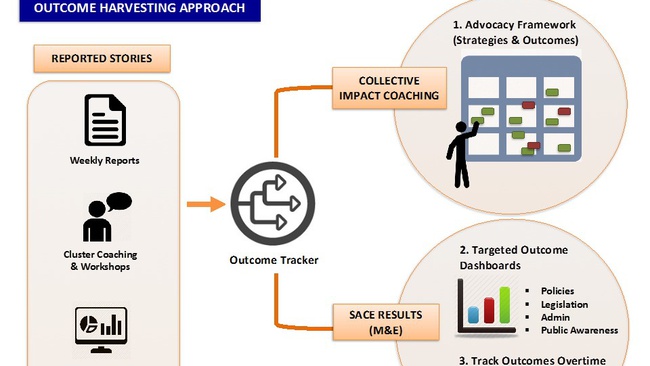The Strategy Matrix/Outcome Harvester
The Strategy Matrix/Outcome Harvesting is a unique evaluation methodology which aids in tracking and collating multiple actions, outputs and interim outcomes on a complex project. It is an evolving map that aims to increase awareness, commitment, and action among different types of audiences by cluster actions and outcomes. How the cluster chooses to carry out actions around their issues depends on strategies and tactics which are captured on the Harvester map. The system tracks and evaluates reported information from partners on their engagement. These information is tracked mainly through a tool called cluster coaching and other information sharing platforms such as the Annual Learning Summit, weekly and quarterly reports. All stories and information are reviewed and coded for patterns and learning on Cluster’s performance and to support further capacity development, public engagement and public awareness actions.
The Strategy Matrix/Outcome Harvester makes project strategizing, re-strategizing, monitoring, evaluation and tracking easy. It ensures all cluster members are on the same page, have a shared goals with assigned roles. It fosters the collective impact approach as cluster members are aware of their roles in contributing to meeting democratic key reform with and without program funding. It helps independent evaluators to follow the project progress – with a ‘map’ of the connections between activities and outcomes – as the coding helps to track progress and complexities and ensure progress beyond the project life time. The tool is cost effective, shows a clear journey map, highlights what strategies and tactics achieved high results for onward replication; and ensures everyone understands project priorities and responsibilities going forward. This tool can be used on any project as it guides in making informed systematic decisions and evaluate project development impacts.
The Strategy Matrix/Outcome Harvester though complex methodology is easy to understand and replicate. The approach to Outcome Harvesting is very inclusive that every member of the cluster understands the journey mapped.
Initially the 'coding' was technical for clusters to understand, but with practice and training it became easier and they each apply have set up an Outcome Harvester grid in their offices.
The Strategy Matrix/Outcome Harvester works best in achieving clarity in complex multi-prong projects and can be used for governance projects as it aids in documenting intangible outcomes as compared to service delivery projects.
